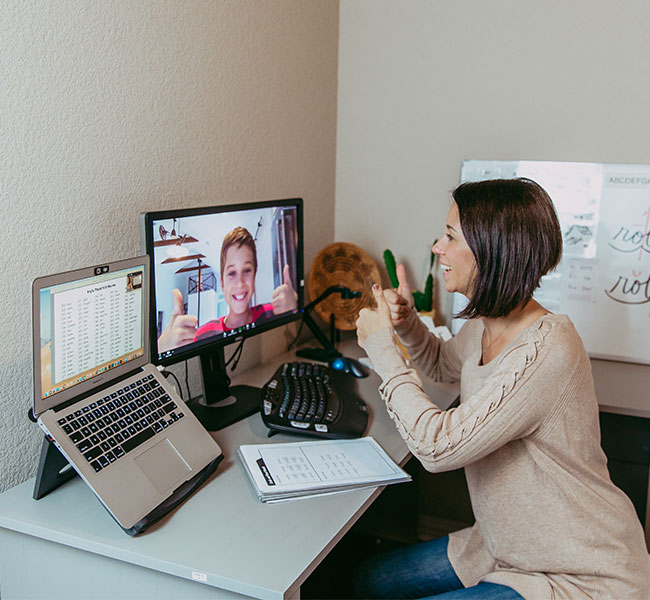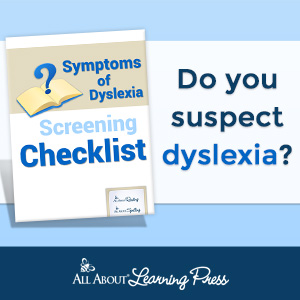When I had an opportunity to connect with dyslexia specialist Megan Pinchback, CALT, LDT and mother of five, I knew I couldn’t pass it up. This remarkable mom is on a journey to change the world one child at a time through her company Dyslexia on Demand. With a heart for dyslexic students, she realized that so many children were suffering needlessly and going untreated across the nation due to a lack of qualified and certified language therapists. Combined with her background as a reading specialist and dyslexia therapist, this prompted her to create a company offering virtual 1-on-1 dyslexia therapy to the students that need her most.
As a homeschool mom of a dyslexic child myself, I know first-hand just how confusing it can be to navigate any special learning challenges when it comes to kids, so I was full of questions for Megan, both as a mom and as a teacher. I couldn’t wait to hear what she had to say about working with dyslexic kids. If you’re in the same situation, get ready to learn a lot!

What is dyslexia?
Dyslexia is essentially a neural-biological disorder of the brain where an individual’s phonological processor doesn’t work correctly. In essence, it simply means a person’s brain is wired differently so their sound-symbol correspondence is not working. This leads to difficulty in decoding words and ultimately affects reading comprehension and every aspect of reading and writing. Dyslexic children often have higher than average IQs but struggle to learn how to read and write.
What are the early warning signs of dyslexia?
The first signs a parent might notice are young children who have trouble with word play such as rhyming and syllabication, which is breaking words into syllables. Later on, parents may notice difficulty or delay in memorizing the letters and sounds, and trouble blending letters together. These kids may love to be read to but are reluctant to read themselves and struggle with simple sight words or the tell-tale reversals of letters. As they do begin to decode, they struggle to hold words in their minds and may even forget the beginning of a long word they are sounding out before they even reach the end of the word.
READ: Do You Know Your Child’s Learning Style?
What age does dyslexia typically manifest?
Age 7 is the magical age for dyslexia. However, it depends greatly on several factors. For example, if there is a family history of dyslexia and the child has been exposed to direct reading instruction, a child might be evaluated at age 5 ½ or 6, although that is rare. An individual can be evaluated for dyslexia at any age, even as an adult. It is not a disorder that goes away, although it can be successfully treated.
What should a homeschool parent do if they suspect dyslexia?
There are really two options if a parent suspects their child may have dyslexia. First, you can hire a private neural-psychologist to evaluate your child, but it comes with a hefty price tag, as in several thousand dollars. The other alternative is to go to your local school, where your child would attend, and request an FIE, a Full Individual Evaluation. It’s important not to go in simply saying, “I think my child has dyslexia”. Instead, request the complete, full special education assessment. By law, the school must provide your child with a full and complete examination for free. As you are filling out the paperwork, then indicate in writing that you suspect dyslexia. At a public school, an LSSP, a Licensed Specialist in School Psychology, will evaluate your child using the same or similar process as that expensive neural-psychologist and you will get the same result for a lot less money!

What should a parent do after receiving a dyslexia diagnosis for their child?
The most important thing a parent can do, if possible, is find a CALT who can provide dyslexia therapy for these students. A CALT is a Certified Academic Language Therapist, a highly skilled therapist specifically trained to help dyslexic students build new neural-pathways in the brain that rewire it in ways that overcome these reading challenges. A CALT has a masters degree plus an additional two years of specific courses and training in dyslexia as well as 700 hours of clinical experience working with students. Another important thing, if your child qualifies as dyslexic through the local public school, is to ask that they be serviced as a special education student, rather than under a 504. Your child may be eligible to receive some support from the school even if they are homeschooled, although you will still want to find a CALT for dyslexia therapy.
READ: 100 Must-Read Books for Kids – The Complete Elementary Reading List
What is dyslexia therapy?
Dyslexia therapy is intensive treatment with a trained CALT to rebuild new neural-pathways in the brain. This intensive therapy involves 180 minutes per week of 1-on-1 interaction, distributed into 4 hour-long sessions. Dyslexia therapy usually follows either the Take Flight program or the Basic Language Skills program and takes the place of the student’s regular language arts instruction. The focus is on building a strong literacy foundation through therapy in phonemic awareness, fluency, comprehension, vocabulary, and multi-sensory structured language. Therapy is not a short, quick, or inexpensive alternative. I like to compare it to investing in orthodontic braces for your child. It is a 2-year, long term-commitment and also a heavy financial investment, but it provides your dyslexic child with the best foundation for their future.
Where can parents find a CALT who does dyslexia therapy?
Unfortunately, there are not many CALTs around the country and most of them are centralized in Texas. That’s one reason why I started my company providing therapy 1-on-1 online so we could virtually reach students who otherwise would not have access to dyslexia therapy. Although dyslexia therapy can be very expensive, our company, Dyslexia on Demand, offers scholarships to families who find it to be a financial hardship. This summer, we are offering 15% off therapy services. Also, you can find the lowest price working with CALTs who have completed all of their course work and training but are still collecting the required number of therapy hours. If you’re interested in learning about therapy and what it is like, we have an upcoming information session happening on June 21st.
What accommodations or changes should a homeschool parent make to support a child with dyslexia?
For at home instruction, parents should lean towards multi-sensory approaches to learning. For example, listening to audio books, reading aloud, and using assisted technology such as speech-to-text. Dyslexic students may require additional time to complete tasks or exams, questions read aloud, or opportunities to show their learning orally rather than in written form. These are not a crutch, but simply leveling the playing field for dyslexic students. Since many dyslexic students are co-morbid with other disorders such as ADHD and limited short-term working memory, they may also benefit from breaking multi-step instructions down into 1-step tasks.
Some homeschool programs are also shown to be more effective for dyslexic students. Reading and spelling programs that follow the Orton-Gillingham method, such as All About Spelling, are valuable for these students. I have also heard of parents having success with Logic of English and Nessy. Sometimes homeschool parents also try to find tutoring programs that cater to dyslexic students, such as Barton. While these might be effective for mild cases of dyslexia, they cannot replace dyslexia therapy, but rather work side-by-side along with the dyslexia therapy to give these children the best possible prognosis.
READ: 7 Ways to Get Kids Hooked on History

My Take-Aways
Wow! Thank you, Megan! What a phenomenal outreach you’ve created for dyslexic kids around the globe. I learned so much, but here are my three biggest take-aways:
To parents:
You don’t have to navigate alone! While dyslexia is a life-long condition, it is treatable and therapy is accessible for your child through online dyslexia therapy.
To students:
You have equal access to free diagnosis through your local public schools. Plus the best news – you can build new neural-pathways to learn how to thrive with dyslexia so school won’t be so hard anymore.
For learning:
Dyslexic students thrive with a multi-sensory approach to learning combined with therapy to create new neural-pathways in the brain.
Truly, the impact Megan and her team are having on children all over the world is remarkable, changing lives one child at a time.
Up Next:
- 1st Grade Book List
- 2nd Grade Book List
- 3rd Grade Book List
- 4th Grade Book List
- 5th Grade Book List
- 100 Must-Read Classic Books for Kids – The Complete Elementary Reading List


Psst! Pin this for later so you’ll be able to find it when you need it!


Pingback: Spectacular 3rd Grade Books: Comedy, Mystery, & History - Maestra Mom
Pingback: Stop! Do You Know Your Kid's Reading Level? - Maestra Mom
Pingback: What is a Running Record & Why You Should Use It - Maestra Mom
Pingback: Phonics for Kindergarten and Pre-K - Maestra Mom -
Pingback: Classic 1st Grade Books for a New Generation - Maestra Mom
I did not know that 7 was the magic number! Plus so many other facts here!
It is interesting, isn’t it? I believe dyslexia can manifest at different ages, but by age 7 a child has usually received enough direct literacy instruction to demonstrate difficulties.